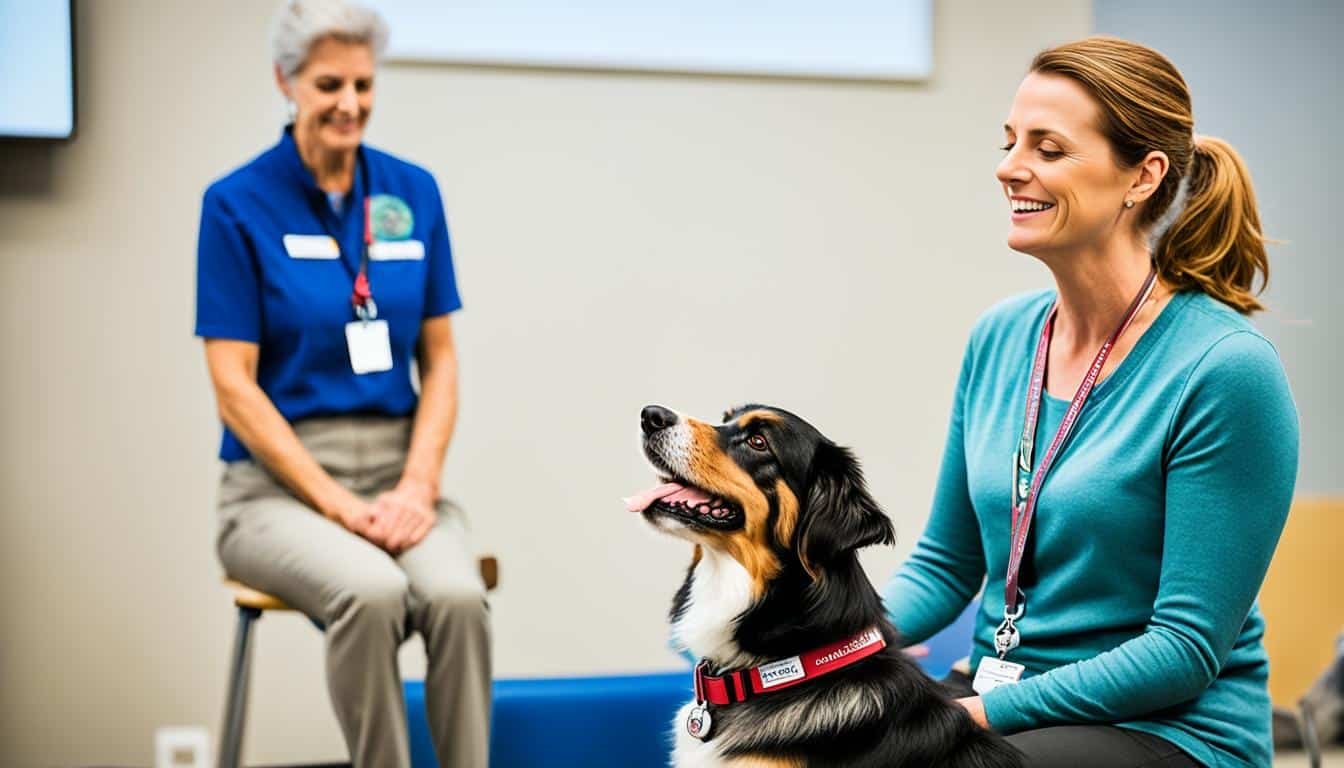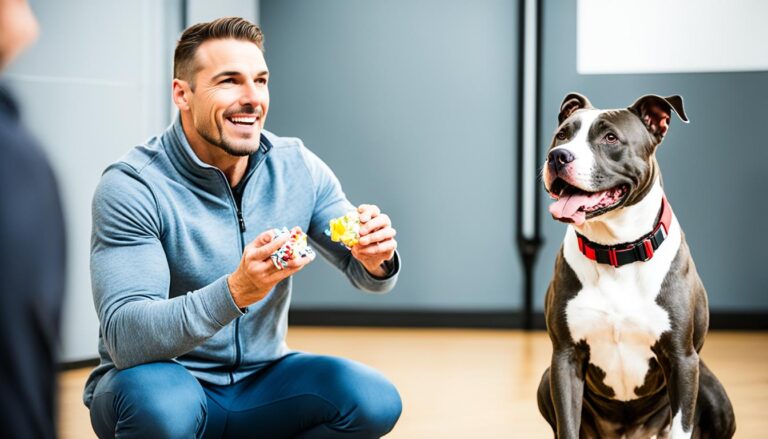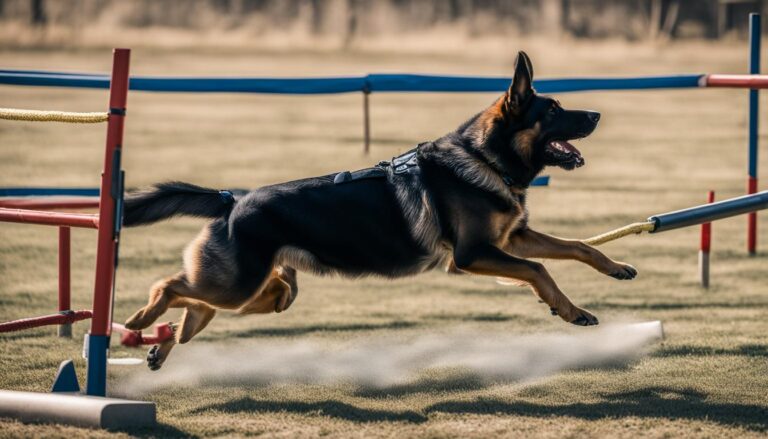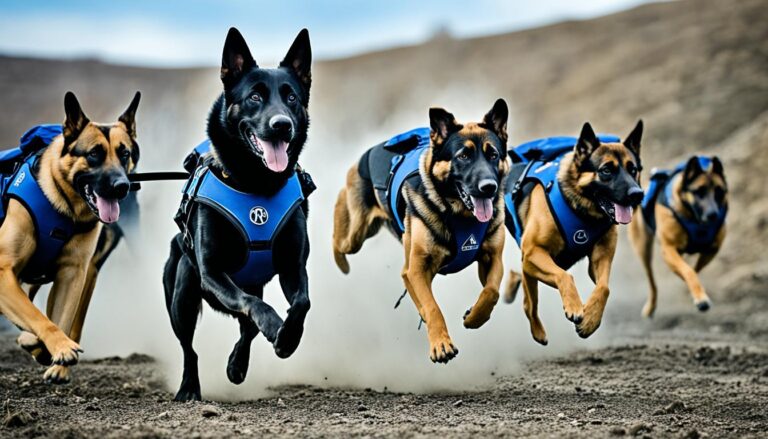How to Train a Therapy Dog
Have you ever experienced the unconditional love and comforting presence of a therapy dog? They have the remarkable ability to bring solace and joy to those in need, making a profound difference in their lives. Perhaps you’ve witnessed the magical connection between a therapy dog and someone going through a difficult time, and it has touched your heart in ways words can’t describe.
That’s why I’m here today, to guide you through the process of training a therapy dog, so you too can be a part of this incredible experience. Whether you’re considering training your pet or seeking guidance to enhance their therapy abilities, this article is packed with valuable insights, expert tips, and best practices to ensure your furry friend becomes a well-prepared and compassionate therapy dog.
In this article, we will delve into the definition of a therapy dog, explore the qualities that make them suitable for this role, assess your dog’s suitability, discuss the training methods, and the importance of the Canine Good Citizen test. We will also guide you in choosing a reputable therapy dog organization and offer advice on making therapy dog visits that have a meaningful impact on the lives of others.
Are you ready to embark on this rewarding journey with your beloved canine companion? Let’s dive in and discover how to train a therapy dog together!
What Is a Therapy Dog and Why Train One?
Therapy dogs play a crucial role in providing comfort and affection to individuals in various facilities, such as hospitals and nursing homes. Unlike service dogs, therapy dogs are not trained to perform specific tasks for individuals with special needs. Instead, their main purpose is to bring emotional support and joy to those they visit.
Therapy dogs offer numerous physical and emotional benefits to the humans they interact with. For example, their presence has been shown to reduce anxiety and stress levels, as well as increase the release of feel-good hormones called endorphins. These positive effects can have a significant impact on the well-being of both patients and residents.
Training a therapy dog not only benefits the humans they visit but also enhances the overall well-being of the dog itself. Through training, therapy dogs learn important skills such as staying calm in various environments, interacting gently with strangers, and following basic obedience commands.
By becoming a therapy dog, your furry friend has the opportunity to make a real difference in the lives of others while enjoying a sense of purpose and fulfillment. Whether it’s brightening someone’s day in a hospital ward or bringing comfort to an elderly resident, the impact of a therapy dog’s presence can be immeasurable.
Therapy Dog Benefits:
- Reduces anxiety and stress levels
- Increases the release of endorphins
- Brings comfort and joy to individuals in need
- Enhances the well-being of the dog
Qualities of a Good Therapy Dog
Not all dogs are suitable for therapy work. If you are considering training your dog to become a therapy dog, there are certain qualities they should possess. Here are the key requirements for a good therapy dog:
- Calm and Friendly: A therapy dog must have a naturally calm and friendly temperament. They should be comfortable and at ease when interacting with strangers, showing genuine affection and empathy.
- Well-Trained in Basic Obedience: Basic obedience training is essential for therapy dogs. They should be able to follow commands such as sit, stay, come, and leave it. This training ensures that the dog can behave appropriately during therapy sessions.
- Social Temperament: A therapy dog should enjoy interacting with new people and be comfortable in various social settings. They must be able to handle different environments, noises, and distractions without getting anxious or agitated.
- Stable and at Least One Year Old: Most therapy dog organizations require dogs to be stable and have reached at least one year of age. This ensures that the dog has matured physically and emotionally, making them better suited for therapy work.
- No Specific Age or Breed restrictions: While age and breed do not matter for therapy dogs, the dog must have the right temperament and disposition. Dogs of all breeds, sizes, and ages can become exceptional therapy dogs if they meet the necessary requirements.
Training and temperament are vital factors when considering a dog for therapy work. If your dog possesses these qualities, they may have great potential to become a therapy dog and bring comfort to those in need.
In the next section, we will discuss how to assess your dog’s suitability for therapy work and the importance of temperament testing.
Assessing Your Dog’s Suitability
Before embarking on therapy dog training, it is crucial to assess your dog’s temperament and behavior. A therapy dog should possess specific qualities to excel in providing comfort and companionship to others in need.
Watch how your dog interacts with new people. Does your furry friend enjoy receiving affection from strangers? A therapy dog should have a calm and friendly disposition, seeking attention from and showing comfort around different individuals.
To ensure your dog’s suitability as a therapy dog, regular health check-ups and grooming are essential. Maintaining their well-being not only keeps them in top form but also ensures they meet the eligibility requirements for therapy dog certification.
To determine if your dog has the right temperament for therapy work, consider participating in a therapy dog assessment or temperament test. These evaluations assess your dog’s ability to remain calm, friendly, and adaptable in various scenarios.
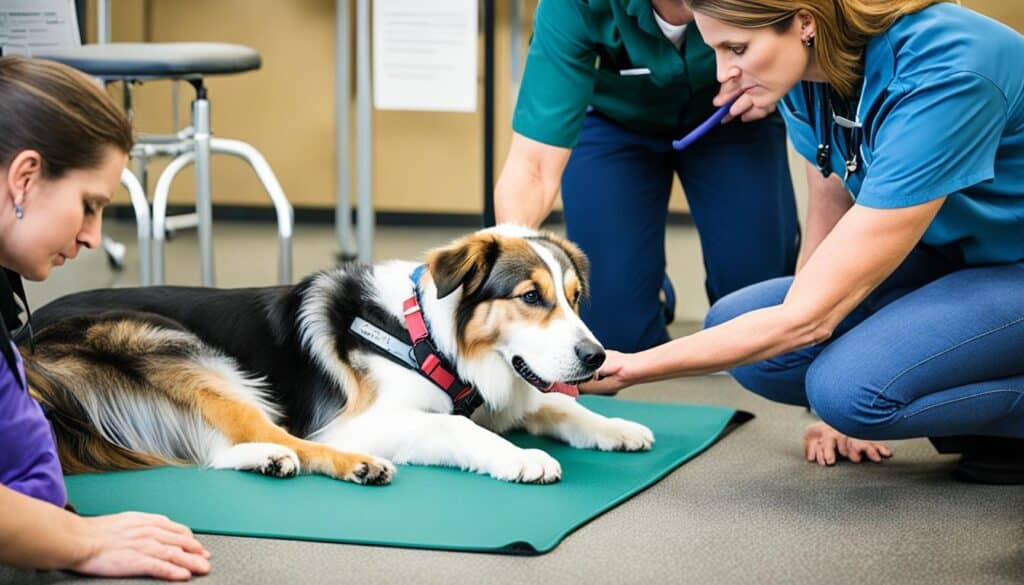
By carefully assessing your dog’s suitability, you can determine if they possess the qualities necessary to become a successful therapy dog.
Becoming a Therapy Dog Handler
As a handler, you play a crucial role in facilitating therapy dog visits and creating positive experiences for both your dog and those you visit. To effectively fulfill this role, it’s important to develop the necessary skills and knowledge through various avenues.
One way to enhance your abilities as a therapy dog handler is to join a national or local therapy chapter. These organizations offer social events and training assistance, allowing you to connect with like-minded individuals and learn from experienced handlers. Being a part of such communities can provide valuable support and guidance throughout your journey as a handler.
Mentorship is another valuable resource for honing your skills. Finding an experienced therapy dog handler who is willing to mentor you can provide personalized guidance and insights, helping you navigate different situations and challenges that may arise during visits.
In addition to joining therapy chapters and seeking mentorship, consider enrolling in cognitive dog training courses. These courses provide a deeper understanding of canine behavior and teach you effective training techniques specifically tailored for therapy dogs. By expanding your knowledge and skills, you’ll be better equipped to handle various scenarios and ensure a positive experience for everyone involved.
Understanding your role as a therapy dog handler goes beyond training and technical skills. Developing strong communication and interpersonal skills is essential for successfully connecting with clients and creating a welcoming environment. Building rapport and establishing trust with the individuals you visit can significantly enhance the therapeutic impact of your dog’s presence.
Remember, becoming a therapy dog handler is not just about the dog; it’s about the impact you can make in the lives of others. By continuously learning, seeking support, and embracing your role, you’ll be well-prepared to embark on a fulfilling journey as a therapy dog handler.
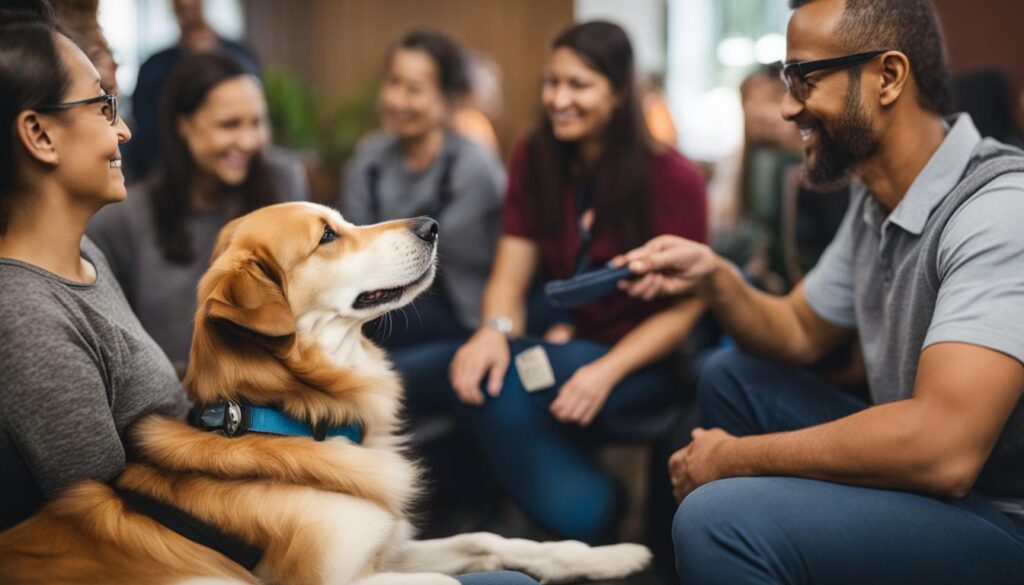
Training Methods for Therapy Dogs
Training a therapy dog is a rewarding journey that requires effective methods to ensure success. Whether you choose to train your dog independently or seek the guidance of a well-educated trainer, there are several approaches you can take to help your furry friend become the best therapy dog they can be.
Private training sessions or group classes that focus on Canine Good Citizen (CGC) test behaviors are highly recommended for therapy dog training. These classes provide structured training environments where you and your dog can learn and practice the necessary skills together.
Positive reinforcement training is a key component of therapy dog obedience training. By focusing on the behavior you want to encourage, such as sitting calmly or interacting with strangers in a calm manner, you can effectively shape your dog’s behavior. Rewarding your dog with treats, praise, or playtime when they exhibit the desired behavior helps reinforce their understanding of what is expected of them.
Here are some important training skills for therapy dogs:
- “Leave it” command: Teach your dog to ignore objects or food that you do not want them to engage with during therapy visits.
- Loose-leash walking: Train your dog to walk politely on a leash without pulling or lunging.
- Calm interaction with strangers: Help your dog become comfortable and friendly around new people by practicing positive socialization techniques.
Remember, consistency and patience are key when training a therapy dog. Celebrate small victories and continue practicing regularly to solidify their training.
Training your dog as a therapy dog requires a combination of dedication, positive reinforcement, and effective training methods. By investing time and effort into their training, you can ensure that your dog is well-prepared to bring comfort and joy to those in need.
The Importance of Canine Good Citizen Test
Many therapy dog organizations require dogs to pass the Canine Good Citizen (CGC) test. The CGC test assesses a dog’s obedience and manners, ensuring they have the necessary skills for therapy work. Training your dog in behaviors like “come”, “sit”, “stay”, and “down” is essential for their success as a therapy dog.
The Canine Good Citizen test provides a solid foundation for therapy dogs to respond appropriately in different situations. It helps dogs learn to interact with other dogs and people in a calm and well-mannered manner. By passing the CGC test, your dog demonstrates their readiness and suitability for therapy work.
Some of the items tested in the CGC test include:
- Accepting a friendly stranger
- Sitting politely for petting
- Walking on a loose leash
- Walking through a crowd
- Sitting and lying down on command
- Staying in place
- Reacting calmly to other dogs
- Reacting calmly to distractions
- Being handled by a veterinarian
Training your dog to pass the Canine Good Citizen test is an important step on the path to becoming a certified therapy dog. It shows that your dog has the necessary obedience and manners to bring comfort to those in need. The CGC test is a valuable milestone that enhances your dog’s credibility as a therapy dog and increases their chances of being accepted into therapy dog programs and organizations.
Choosing a Therapy Dog Organization
When it comes to certifying your therapy dog and ensuring liability coverage, joining a reputable therapy dog organization is essential. These organizations provide the necessary guidance and resources to help you and your dog make a positive impact in your community. Here’s what you need to consider when choosing a therapy dog organization:
- Research local therapy dog groups: Start by researching therapy dog organizations in your area. Look for organizations that have a strong reputation and a focus on the specific type of therapy work you’re interested in.
- Contact facilities where you intend to volunteer: Reach out to the facilities where you plan to make therapy dog visits and ask about their preferred therapy dog organizations. Some facilities may have specific requirements or partnerships in place.
- Check lists provided by reputable sources: The American Kennel Club (AKC) and other reputable sources often provide lists of recognized therapy dog organizations along with their specific requirements. Use these lists as a starting point for your research.
- Consider insurance coverage: As a therapy dog handler, it’s crucial to have liability insurance. During therapy visits, unforeseen incidents can occur, and having insurance coverage through your chosen organization will help protect you in such situations.
By carefully selecting a therapy dog organization, you can ensure that both you and your dog receive the necessary support and training to make a real difference in the lives of others.
Making Therapy Dog Visits
Once your dog has passed the necessary tests and certifications, it’s time to embark on your therapy dog journey. Register with a national therapy dog organization to start making visits and bring comfort to those in need. Participating in animal-assisted therapy settings and engaging with the community can have a positive impact on both the dog and the handler.
Therapy dog visits provide an opportunity to brighten lives and improve the well-being of individuals in various facilities such as hospitals, nursing homes, and schools. These visits can create moments of joy and offer companionship to those who may be feeling lonely or going through challenging times. It’s truly a rewarding experience for both the dog and the handler.
As you continue your therapy dog visits, you may also consider applying for additional titles to recognize your dog’s achievements. The AKC Novice Therapy Dog title, for example, is an honorable designation that showcases your dog’s dedication to therapy work. By completing a certain number of visits, you can demonstrate your dog’s continued commitment to bringing comfort and joy to others.
